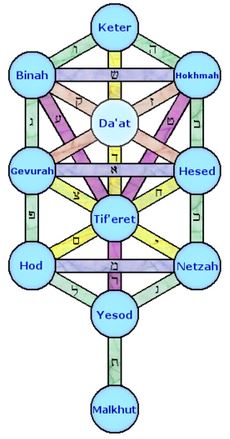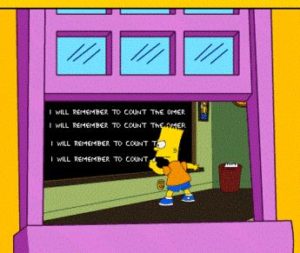The Torah commands that each day between the holidays of Pesach and Shavuot be verbally counted (Leviticus 23:15). Along with this counting, a bundle of barley was brought as an offering in the Holy Temple. The barley was measured in units of omer, with one omer being equal to approximately 3 litres. Today, we no longer have a Temple or barley offerings, but the mitzvah of counting the days between Pesach and Shavuot remains, and is referred to as Sefirat HaOmer, “the Counting of the Omer”. Since there are exactly seven weeks between the two holidays, there are 49 days which need to be counted. What is the deeper meaning behind this seemingly mundane practice?
The Fifty Levels
There are a number of spiritual explanations for Sefirat haOmer. Perhaps the most popular is the idea that in Egypt, the Jews were so deeply mired in the immoral and idolatrous Egyptian society that they had descended all the way down to the 49th level of impurity.
It is said that there are 50 levels of impurity, rooted in (or at least suggested by) the numerical value of the Hebrew word for “impure” (tam’e, טמא) which has a gematria of 50. The Jews had stooped down to the 49th level, and had they reached the 50th, there would have been no hope of salvation for them. Thus, God cut short the 400 year period of slavery that was decreed upon them, and immediately took the Jews out of Egypt before they could fall any further.
Corresponding to these, the Jewish mystics teach that there are 50 levels of constriction in the world. Egypt represented these 50 constrictions. Again, this can be illustrated through Hebrew and gematria: Egypt is Mitzrayim (מצרים), the root of which is tzar (צר, meaning “constrict” or “narrow”) and the suffix of which is ים, numerically equalling 50. Egypt is the land of 50 constrictions.
Following the Exodus, the task of the Jews was to cleanse themselves of the 49 levels of impurity which they had acquired, and to break free from all those constrictions that were imposed upon them. This is why they needed a 49-day period – one for each impurity and constriction – before they were ready for the Divine Revelation and reception of the Torah at Mt. Sinai on Shavuot.
The Tree of Life
The Passover Haggadah reminds us that each Jew must envision themselves as personally coming out of Egypt. Though we are thankfully no longer literally slaves, the truth is that each of us is still mired in some kind of constriction, be it a constriction to time or work, money or health, stress, fears, and all those others things that “narrow” our lives and confine us into various forms of spiritual slavery. The Torah commands each of us to break free, to remove all of those impurities and boundaries, and to elevate ourselves over this special period of 49 days. Each day is associated with a unique energy to help us in this path.
The 49 energies stem from the Kabbalistic “Tree of Life”. This Tree is composed of ten Sefirot (a term not coincidentally related to Sefirat HaOmer). These Ten Sefirot are regarded as the spiritual building blocks with which God created the universe (together with the twenty-two letters of the Hebrew alphabet). It is said that all things in existence are permeated with these ten energies, and all things that are “ten” in the Torah correspond to the ten sefirot: the Ten Divine Utterances of Creation, the Ten Trials of Abraham, the Ten Plagues, the Ten Commandments, etc.
The top three sefirot are called the Mochin – the mental or intellectual faculties. The bottom seven are referred to as the Middot – the emotional and practical elements. During the time of the Omer, we are meant to focus on the purification of the bottom seven sefirot. Meanwhile, on Shavuot – having received the Torah – we are then able to rise further to the upper three mental sefirot and focus on intellectual development.

Etz Chaim, “Tree of Life”, Showing the 10 Sefirot and the 22 Lines that Unite Them (Corresponding to the Hebrew Alphabet), as Depicted by the Arizal
Therefore, each of the seven weeks between Pesach and Shavuot is associated with one of the seven Middot. The first week of the Omer corresponds to the sefirah of Chessed – kindness. The second to the sefirah of Gevurah – restraint and self-control. The third to Tiferet – balance (also called Emet – truth). The fourth is Netzach – “victory”, or persistence (often associated with faith). The fifth, Hod – gratitude, and the sixth, Yesod – literally “foundation”, referring to sexual purity. Lastly there’s Malkhut, “kingdom”, which is associated with the faculty of speech.
Each of the seven days of the week is further associated with one of these seven sefirot. So, the first day of each week corresponds to Chessed, and the second day of each week to Gevurah, and so on. This gives each of the 49 days a totally unique quality which one should be meditating on, and more importantly, attempting to rectify.
For example, tonight we will count the third day, with the corresponding sefirah of Tiferet sh’b’Chessed, “Balance (or Truth) in Kindness”. This suggests developing a harmonious approach to kindness: being a more giving person; charitable, helpful, sympathetic, but also making sure not to be taken advantage of or tricked into false kindness. Unfortunately, misplaced kindness has become a staple of Western society. (How often do we see well-meaning liberals supporting the “poor and disadvantaged” terrorists?) Tonight’s sefirah might be summarized well by the old Midrashic teaching that “those who are kind to the cruel will ultimately be cruel to the kind.”
Similarly, each of the remaining 49 days has a powerful message to teach us, hence the tremendous importance of Sefirat HaOmer – counting and meditating upon each and every one of these very special days.
The article above is adapted from Garments of Light – 70 Illuminating Essays on the Weekly Torah Portion and Holidays. Click here to get the book!

